Introduction
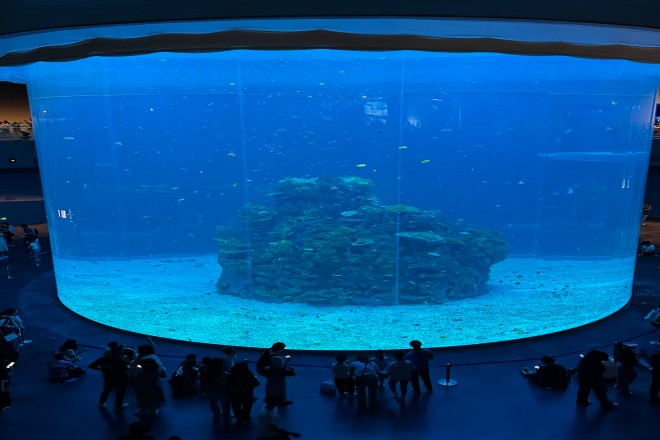
The aquarium, as a window to the deep blue world, has always been committed to presenting the magnificence and mystery of the ocean with the latest technology.
The innovation of Affichage LED technology is like a breath of fresh air, injecting new vitality into the display method of the aquarium. It not only greatly enriches the display content but also brings tourists into immersive ocean adventures through dynamic images and interactive experiences.
This article will provide an in-depth analysis of the innovative applications of LED displays in aquariums and their future development.
1. What is the current application status of LED displays in aquariums?
1). Popularity
With the rapid development of science and technology and people’s increasing requirements for viewing experience, the popularity of LED display screens in aquariums is significantly increasing.
From internationally renowned large-scale aquariums, such as famous aquariums located around the world, to local small aquarium exhibition venues, LED displays have become an indispensable part and are widely used in various display and interactive links.
2). importance
- Améliorer l'expérience de visionnage :
With its high resolution and rich colors, LED displays can present realistic underwater landscapes and vivid images of marine life. Visitors feel as if they are in the vast ocean world.
This immersive feeling greatly enhances the viewing experience and enables tourists to have a more intuitive and profound understanding of marine life.
3). Enhance interactivity:
Through LED displays, the aquarium can interact with tourists in real-time. For example, set up an audience voting session to allow tourists to participate in deciding the next performance content; or use a question and answer session to allow tourists to learn more relevant knowledge while appreciating marine life.
This interactivity not only increases the fun of viewing, but also improves visitor participation and satisfaction.
4). Improve information dissemination efficiency:
As a medium for information dissemination, the LED display screen has real-time and intuitive characteristics. The aquarium can use LED displays to broadcast various information in real-time, such as performance times, venue navigation, precautions, etc.
This not only makes it easier for tourists to understand relevant situations but also improves the management efficiency of the aquarium, making the tour process smoother and more enjoyable for tourists.
2. What types of LED displays are used in aquariums?
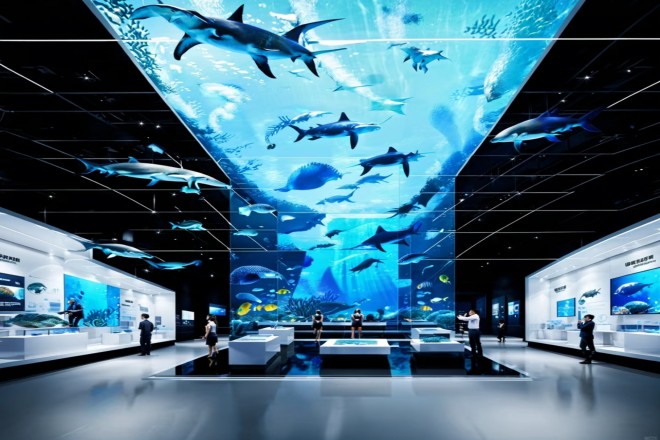
1). LED sky screen
- Caractéristiques:
LED sky screens are famous for their high luminosité, haut fréquence de rafraîchissement and high resolution. It is usually suspended or mounted on the ceiling of the aquarium, like a strip of colorful satin or a bright and deep sky, giving visitors a shocking visual experience.
- Decorative effect and atmosphere creation:
The LED sky screen in the aquarium can create a fantasy atmosphere as if you are in the underwater world.
By playing videos of underwater creatures swimming and the natural landscape of the ocean, visitors can feel the magnificence and mystery of the vast ocean the moment they enter the aquarium.
- Specific applications:
For example, the sky screen of an aquarium plays pictures of various marine creatures swimming freely in the blue water, accompanied by realistic sound effects, making visitors feel as if they are in the underwater world and experiencing the wonderful feeling of dancing with marine creatures.
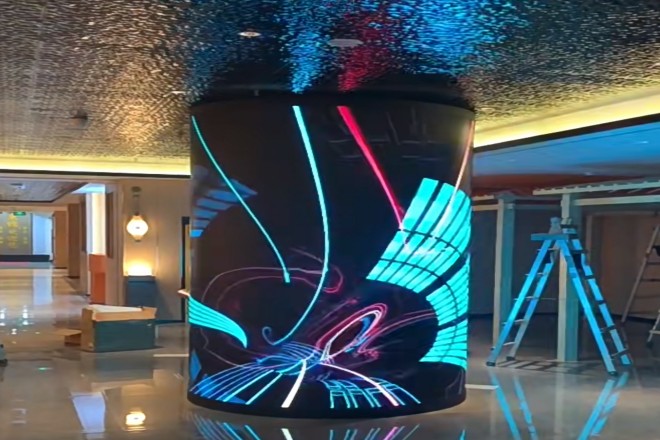
2). LED cylindrical screen
- Design novelty and fashion sense:
The design of the LED cylindrical screen is novel and fashionable and perfectly matches the shape of the building. Its high brightness, accuracy, and wide viewing angle make it a beautiful sight in the aquarium.
- Multi-angle viewing experience:
Cylindrical screens can break the visual limitations of traditional flat displays and provide a multi-angle viewing experience. Visitors can clearly see the content on the screen no matter where they stand.
- Specific applications:
In the aquarium, the cylindrical screen can be used as an independent display area to display close-ups of rare marine life, the evolution of marine life, and other information. For example, a cylindrical screen displays high-definition close-ups of various rare marine creatures, allowing visitors to increase their knowledge while enjoying the beautiful scenery.
3). LED spherical screen
- 360° full viewing angle and structural complexity:
The LED spherical screen has a 360° full viewing angle and can play videos in all directions. Its structure is complex and requires special technology and craftsmanship for production and installation.
- Unique display focus:
In the aquarium, the spherical screen is undoubtedly a unique display focus. It can attract tourists’ attention and become a popular spot for tourists to take pictures.
- Specific applications:
The spherical screen can display information such as the distribution of the earth’s oceans and the global distribution of marine life.
For example, a spherical screen displays the distribution of marine life around the world. Through vivid pictures and realistic sound effects, visitors can more intuitively understand the vastness of the ocean and the diversity of marine life.
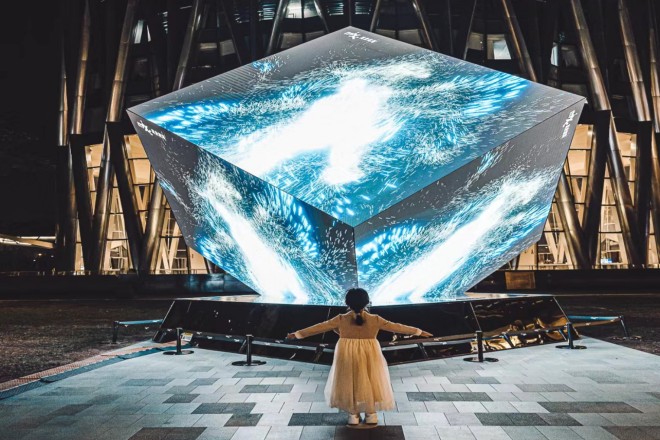
4). Other special-shaped screens
- Irregular flat screen and hyperboloid display screen:
In addition to the common LED special-shaped screens mentioned above, there are also other types of special-shaped screens, such as irregular flat screens and hyperboloid displays. The applications of these special-shaped screens in aquariums are equally wide and flexible.
- Flexibility and customization:
These special-shaped screens can be customized according to the specific display needs of the aquarium and are highly flexible in shape and size.
For example, a hyperboloid display can be used to display some three-dimensional images or scenes of marine life, such as the three-dimensional structure of coral reefs, the swimming trajectories of fish schools, etc.
This kind of display screen allows visitors to feel the forms and activities of marine life more realistically and enhances the artistic and technological sense of the display.
3. The function and role of LED display screen in aquarium
1). Demonstration function
- Realistic underwater landscape display:
The LED display screen can show realistic underwater landscapes, such as coral reefs and colorful fish schools, making visitors feel as if they are in a real ocean environment. These vivid pictures not only enhance the fun of viewing but also increase tourists’ understanding and interest in marine life.
- Display of major aquatic organisms:
In large aquariums, LED displays can be used to display major aquatic life, such as sharks, turtles, etc. At the same time, for ornamental fish tanks in small displays, LED displays can also provide more detailed and vivid displays, allowing visitors to observe and understand these creatures more closely.
2). Educational function
- Provide biological species information:
The LED display can display detailed information about biological species, including their names, habits, distribution areas, etc. This information not only helps tourists better understand marine life but also increases their awareness of conservation.
- Emphasizing the importance of marine ecosystems:
Through LED displays, aquariums can convey to visitors the importance of marine ecosystems and the impact of human activities on marine ecosystems. This information helps tourists realize the urgency and necessity of protecting marine ecology.
- Incorporate information boards for education:
LED displays can be combined with information boards to provide visitors with more comprehensive and in-depth educational content. For example, by playing videos and pictures related to marine life protection, combined with text descriptions and interactive Q&A, tourists can learn more knowledge about marine protection during the tour.
3). Boot function
- Attract tourists’ attention:
Large-size and high-brightness LED displays can attract visitors’ attention and become the highlight and focus of the aquarium. These displays can not only display marine life and landscapes, but can also be used to play navigation information, performance times and other practical information to help tourists better plan their tour routes.
- Guide tourists to visit the route:
Through the guidance function of the LED display, the aquarium can optimize tourists’ visiting routes and reduce congestion and waiting time. At the same time, these displays can also increase the time visitors stay in the aquarium, allowing them to more fully appreciate and understand marine life.
- Improve the value of your visit:
The guidance function of the LED display screen not only improves tourists’ tour efficiency but also enhances their tour experience. Through reasonable layout and design of display content, these displays can enable tourists to obtain more information and fun during the tour, thus improving the tour value of the entire aquarium.
4. The future development trend of LED display screens in aquariums
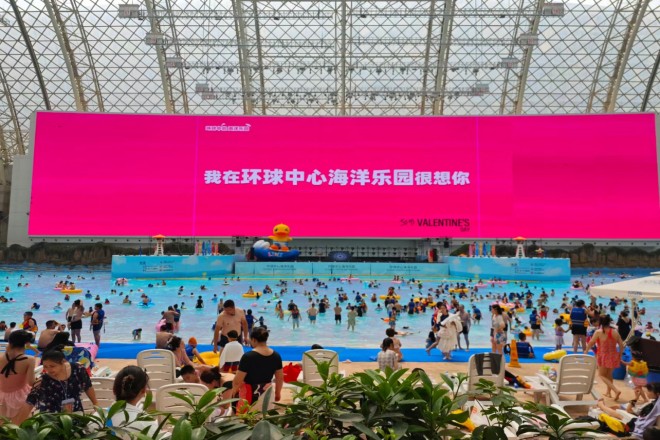
1). Technology optimization and innovation
- Popularity of Ultra HD resolution:
In the future, LED display technology will move toward the popularization of ultra-high-definition resolutions (such as 8K and above), making the display of marine life and landscapes more delicate and realistic and enhancing tourists’ visual enjoyment.
The combination of high dynamic range (HDR) technology will further enhance color saturation and contrast and restore a more realistic underwater world.
- Modular and customized design:
The modular design will make the installation, maintenance, and upgrade of the LED display more convenient while allowing for more flexible customization of size and shape to suit the needs of different aquariums.
Customized services will cover all-round customization from display content to appearance design to enhance the uniqueness and attractiveness of the display.
2). Cross-technology integration and innovative applications
- Deep integration of AR/VR technology:
Through AR technology, tourists can interact with virtual marine creatures on the LED display in a real environment, achieving a seamless connection between virtual and reality.
VR technology will create an immersive underwater adventure experience, and the LED display screen can be used as the entrance or background of the virtual environment to enhance immersion.
- Improvements in intelligent sensing and interactive technology:
Using artificial intelligence and Internet of Things technology, the LED display screen can recognize visitors’ movements and emotions, adjust display content and interaction methods in real time, and provide a more personalized experience.
Improvements in sensing technology will make interactive experiences more natural and smooth, such as interacting with the screen through gesture control or voice commands.
- Rich in multimedia content creation:
With the help of 3D modeling, animation and virtual reality technology, we can create richer and more diverse multimedia content to show the living habits and migration paths of marine life and enhance the educational value.
3). Innovative application scenarios and services
- Construction of immersive experience space:
Utilize LED displays and other visual and auditory technologies to build a full range of immersive experience spaces, such as undersea tunnels, ocean storms, and other simulated scenes, to provide a shocking viewing experience.
- Expansion of education and scientific research functions:
The LED display screen is used as an educational tool and scientific research data display platform, combined with interactive technology, to provide tourists with popular science education on marine knowledge and, at the same time, provide data visualization support for scientific researchers.
- Intelligent management and services:
Remote monitoring and management of LED displays through intelligent systems improves operational efficiency and reduces maintenance costs.
Use big data to analyze tourists’ behavior and preferences, optimize display content and interactive experience, and provide more personalized services.
Conclusion
Looking to the future, the continued leap in LED technology will lead the aquarium into a new era of more intelligent and immersive displays.
The LED display screen not only deepens the viewing and educational value of the aquarium, but also inspires the public’s deep resonance for marine protection.
Enfin, si vous souhaitez en savoir plus sur les écrans LED, veuillez nous contacter.
